Rhetorical Analysis
The Lutheran Immigration and Refugee Service (LIRS) provides a website that encourages the community to help advocate for the global refugee crisis that the world is currently facing (Lutheran Immigration and Refugee Service). LIRS was founded in 1939 in the United States by Lutheran churches (Lutheran Immigration and Refugee Service). The organization was first created to help those who were uprooted during World War II, and their mission has grown since (Lutheran Immigration and Refugee Service). LIRS helps refugees, asylum seekers, migrants in detention, unaccompanied migrant families and other vulnerable individuals (Lutheran Immigration and Refugee Service). The Lutheran Immigration and Refugee Service’s website is an accessible resource for information that helps users understand the confusing global refugee crisis in a way many people can understand (Lutheran Immigration and Refugee Service).
The authors of the Lutheran Immigration and Refugee Service are members of the organization (Lutheran Immigration and Refugee Service). While many various members of the organization may have created the website, the main contributors may include Danielle Bernard, the Director for Marketing and Communications (Lutheran Immigration and Refugee Service).
The intended audience of the Lutheran Immigration and Refugee Service’s website may include immigrants, refugees, vulnerable individuals, donors, political activists or other non-profits (Lutheran Immigration and Refugee Service). The website provides information on how to receive help from the organization, which helps reiterate that the main intended audience is refugees, immigrants, or vulnerable individuals (Lutheran Immigration and Refugee Service). The website allows for information on the overall crisis and provides information on how individuals can help advocate or volunteer for the organization or offers an option to donate to the organization which targets to their secondary audience: political activists and donors (Lutheran Immigration and Refugee Service).
The media’s context is a nonprofit’s online website that portrays a serious tone (Lutheran Immigration and Refugee Service). An online website is the easiest way to display information (Lutheran Immigration and Refugee Service). The genre of the content on the website is informative and persuasive (Lutheran Immigration and Refugee Service). The website provides information to website users about the refugee and immigrant crisis and uses their platform to persuade others to help by donating or volunteering (Lutheran Immigration and Refugee Service).
The purpose of the Lutheran Immigration and Refugee Service’s website is to inform readers of the global crisis and provide a resource for immigrants or refugees seeking help (Lutheran Immigration and Refugee Service). The second purpose of the website is to encourage people to advocate, take action or donate towards the cause (Lutheran Immigration and Refugee Service).
Mode Analysis
Spatial:
The overall layout of the web page is user friendly, clear and accessible. The page has a menu on the top left, and provides menu options including “About Us,” “Our Work,” “Take Action,” etc. The top of the page has two columns of information, but changes into one column and the page ends with an address and menu options to visit their privacy policy, their financial information, their career site, etc. The page follows the same layout as most successful nonprofits. The layout may prove to draw people in, which is why it is used by many nonprofits.
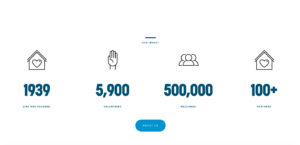
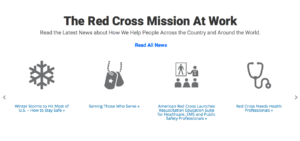
An example of similar layouts used by non profits are shown in the picture above from LIRS and The Red Cross. Both websites have a menu across the top, a single column feature that includes picture icons and words underneath that either portray a message, or provides a link to the topic for more information.
Both The Red Cross and LIRS also have a specific column section on their page for donations. A section dedicated solely to donations may stand out and persuade viewers to donate to the organization.
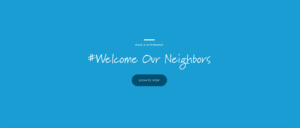
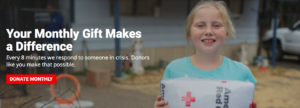
Visual:
When first opening the web page, the dark theme colors stood out. The colors include: blue, white and dark orange. The dark orange is used for the “Donate” button for emphasis, which jumps out to the reader. Since the dark orange stands out and draws you in, the organization may hope that more people will recognize the donate option.
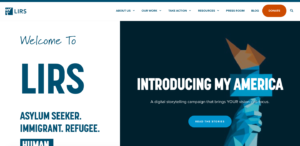
The website includes various of pictures including the hand of the Statue of Liberty, a sparkler and children. The picture that displays the hand from the Statue of Liberty may help remind viewers of our ancestors entrance into America or may reference American’s rights to freedom. The sparkler and children pictures are used to help draw viewers into the blog posts corresponding to the pictures.
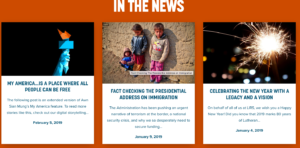
White or blue font is used throughout the page. The font style differs throughout. For example, one section of the website includes thin, fancier lettering, while other sections of the website include thick lettering with a mixture of small and large font. The more critical information is bold faced. The difference in lettering may help reiterate the website’s call to action. The thick bold lettering may be more serious and informative, while the thin fancier lettering calls for individuals to use the hashtag on social media.
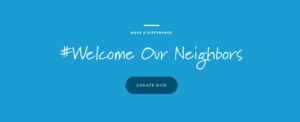
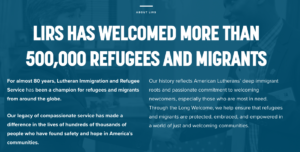
Aural:
The aural mode is silence, as there are no video or sounds played on the website.
Gestural:
There are no gestural modes displayed throughout the website
Linguistic:
The wording used throughout the website is formal, firm, yet simple. The website has both paragraphs and titles. The paragraphs are short enough to get the point across, which makes reading a lot of information easier for the viewer.
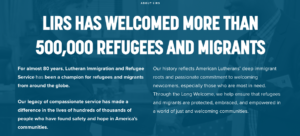
Works Cited:
Lutheran Immigration and Refugee Service. History. n.d. 11 February 2019.
—Our Leadership. n.d. 11 February 2019.
—Resources. n.d. 11 February 2019.
—Take Action. n.d. 11 February 2019.